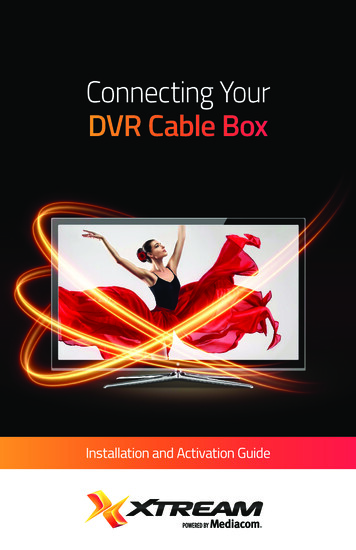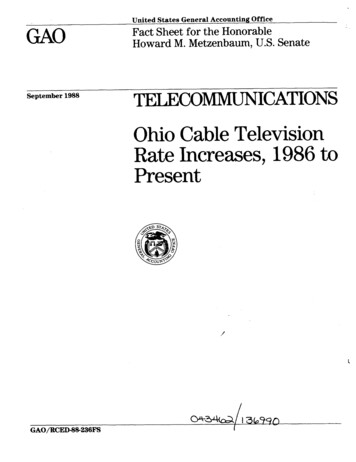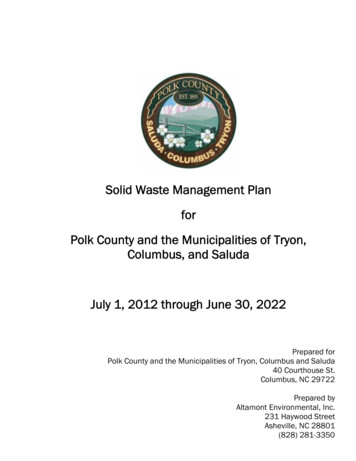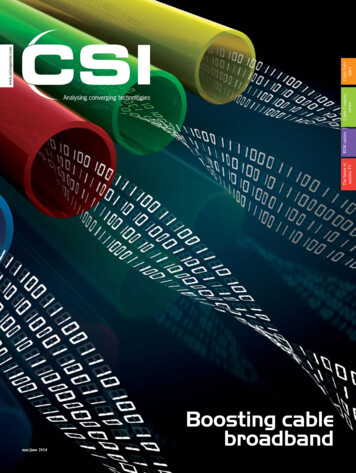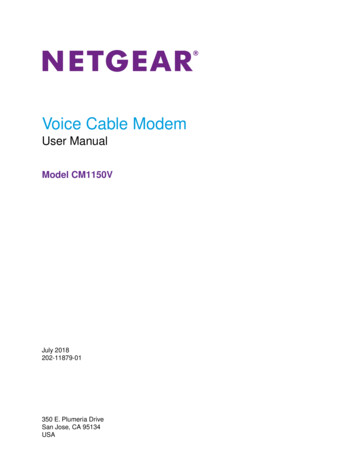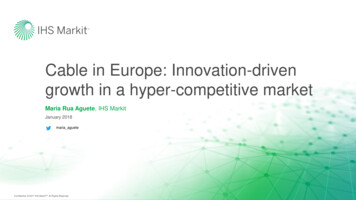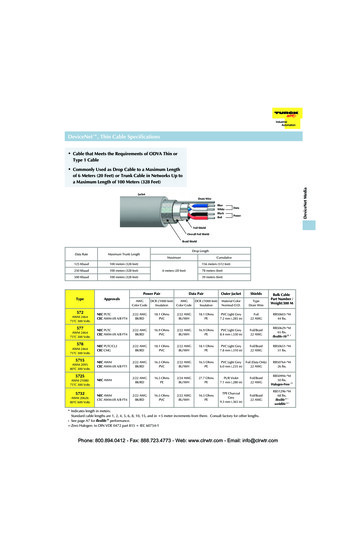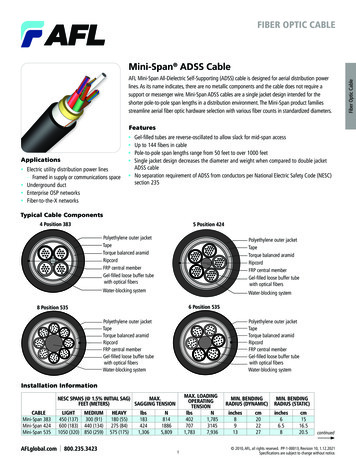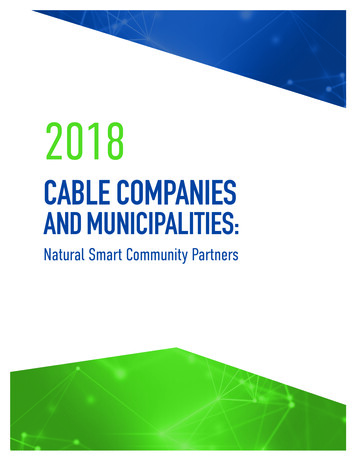
Transcription
2018CABLE COMPANIESAND MUNICIPALITIES:Natural Smart Community Partners
Table of ContentsExecutive SummaryIntroductioni1Smart Community OverviewThe Internet of Things4The IoT Technology StackThe IoT Feedback Loop356Demand for Ubiquitous Connectivity and the Importance of Edge Computing6The Multiple Roles of the Municipality in Smart Community Projects 8Existing Smart Community Partnerships between Cable Companies &Municipalities 10Commitment by the Cable Industry to Expand the Availability of Broadband Services offering GigabitSpeeds 12Comcast’s machineQ13Cox Communications’ Smart Gigabit Communities Partnerships16Charter’s plans to invest in and upgrade their networks will further support Smart Community/IoTprojects 17Key Takeaways18Conclusion Recommendations19About the Author 21Cable Companies and Municipalities: Natural Smart Community PartnersC
Executive SummaryMunicipalities and cable companies are natural partners in the Smart Community/IoT space. A growingnumber of municipal leaders recognize the promise of Smart Community/IoT projects to expandeconomic opportunity and improve the standard of living for residents in their communities. The US Department of Transportation reported that nearly 80 US cities responded to its Smart CityChallenge in 2016. The Global City Teams Challenge, an initiative established by the US Department of Commerceboasts participation of 200 local governments from across the globe. In 2017, Bloomberg Philanthropy announced a “Mayors Challenge” designed to help more than 300cities solve their most urgent problems. In 2018, City Innovate established a Start-up in Residence program with 80 startup-friendlygovernment contracting opportunities from 30 government organizations including SF, Las Vegas,Miami, LA, and Portland.Given the complexity and cost of Smart Community/IoT deployments, most municipalities will benefitfrom public-private partnerships that can help bring scale to Smart & Connected Community efforts.Research conducted by Connected Communities LLC: supports a conclusion that there existunderappreciated affinities between local governments and cable companies and that cable companiesare uniquely well suited partners to local governments in Smart & Connected Community initiatives.Three key findings help support this conclusion.1. Cable networks have the capability to support Smart Community/IoT applications both now andin the future. There is no need for communities to wait for “5G” or other wireless networks to bedeployed before pursuing Smart & Connected Community initiatives. Cable providers possesswired and wireless facilities to deliver Smart Community/IoT solutions. Moreover, decades ofexperience deploying and supporting network-enabled applications and services means that cablecompanies bring critical expertise to Smart Community/IoT deployments.Cable Companies and Municipalities: Natural Smart Community Partnersi
2. A rapid expansion of the number of homes where gigabit service is available means that thesmart home will be an increasingly viable platform capable of advancing Smart & ConnectedCommunity objectives. According to analysis conducted by NCTA, the number of housing unitswhere cable providers offer gigabit service will increase to a projected 72% as of December 2018.The success of applications, including the remote delivery of social services, support of residentschoosing to ‘age at home’ and distance education initiatives, depends on reaching a critical massof customers have access to a smart home where data collection and dissemination occursseamlessly. For this reason, current efforts by cable providers to expand the availability of gigabitservices will be an important driver of the Smart Community/IoT efforts and will be incorporatedinto effective Smart and Connected Community planning.3. Smart and Connected Community partnerships between cable providers and local governmentsreflect new and evolving approaches to collaboration. Rather than approach their localgovernment partners with a one-size fits approach to Smart Community/IoT deployments, cableproviders are working with partners from the local community to co-create approaches thatbest achieve common goals. The most effective Smart and Connected Community partnershipsbetween municipalities and cable providers will build upon decades of experience workingtogether and a shared commitment to the prosperity of the communities they serve but will alsoreflect new approaches to collaboration.Recommendations: Several recommendations for cable companies and municipal leaders are drawnfrom the report’s key findings. Local governments, when planning for Smart and Connected Community, IoT and 5G/SmallCell deployments, will benefit from efforts to engage cable providers and encourage local cableproviders to provide input and participate in the process. Local government leaders and cable companies alike should recognize that anticipated SmartCommunity, IoT and 5G/Small Cell deployments provide a unique opportunity to expand and evolvetheir relationship to include innovative and impactful Smart Community partnerships. Cable companies should educate community leaders so that there is a better appreciation of theend-to-end consumer connectivity, facilities and expertise cable companies possess and how theseresources can be used to advance Smart & Connected Community objectives. Local governments should evaluate carefully whether existing connectivity (e.g., LoRaWAN)can support the desired functionality of Smart and Connected Community applications anddeployments. Cable companies should evaluate opportunities for public private partnerships (“PPPs”)with municipalities, universities and non-profits as a means to grow economic activity in thecommunities they serve and, ultimately, serve new customers and existing customers in new ways.iiCable Companies and Municipalities: Natural Smart Community Partners
IntroductionMunicipal leaders across the country are working to develop and deploy strategies that will advanceefforts to become smart and connected. Examples of municipal efforts range from the deployment ofwater level and flooding sensors in Norfolk (VA), a network of “Fitbits for the City” in Chicago, and thedeployment of the state of the art pedestrian safety sensors in Portland (OR).1 The “Smart City” sector isa large and growing market for telecommunications, IT and software companies, totaling 425 billion is2017 and projected to grow to 1.2 trillion by 2022.2It is difficult to quantify with precision how many municipalities are pursing Smart Community efforts.A 2017 survey of government leaders from 350 jurisdictions found that 200 respondents reportedeither a fully operational “Smart City” initiative, a “Smart City” pilot in their city or a Smart City planningeffort underway.3 The number of local governments participating in Smart and Connected Communityprograms administered by Federal agencies and national foundations supports a conclusion thatlarger American cities (with the resources to apply for grants) are pursuing resources to make theircommunities smart and connected. The US Department of Transportation reported that nearly 80 US cities responded to its Smart CityChallenge in 2016. The Global City Teams Challenge, a “Smart City” initiative established by the US Department ofCommerce’s National Institute of Standards and Technology (NIST), boasts participation of morethan 200 local governments from across the globe. In 2017, Bloomberg Philanthropy announced a “Mayors Challenge” designed to help more than 300cities solve their most urgent problems. In 2018, City Innovate established a Start-up in Residence program with 80 startup-friendlygovernment contracting opportunities from 30 government organizations including SF, Las Vegas,Miami, LA, and Portland.While Smart and Connected Community initiatives present opportunities for municipalities, the initiativesalso present new challenges. Many Smart and Connected Community projects cut across technicalsectors, involve multiple municipal departments and touch the lives of many different communitystakeholders. Traditional workflows may not be well-suited to adopting projects that represent newapproaches to addressing long-standing issues. Deploying new technologies and applications can involverisk. Municipal leaders seek to be innovative while at the same time being good stewards of taxpayer1 See https://www.norfolk.gov/index.aspx?NID 3617, https://arrayofthings.github.io/faq.html, and 3.2MarketandMarkets.com, “Smart Cities Market by Focus Areas,” mart-cities-market-542.html.3CompTIA, “Building Smarter Cities and Communities,” -cities-and-communities.Cable Companies and Municipalities: Natural Smart Community Partners1
funds. The most innovative projects – those with the greatest potential to transform a community –may require pilot deployments to validate the technologies’ return-on-investment (ROI). Due to thesemany challenges, the municipal leaders able to most successfully achieve their communities’ smartand connected objectives will leverage strong partnerships. Partners help municipalities explore andexamine innovative technologies and applications, develop approaches that balance risk and reward anddeliver positive impacts for community residents.Cable companies have an interest in the “Smart City” sector and are uniquely well-suited to Smart andConnected Community partnerships with municipalities. For initial deployments and pilot projects, cablecompanies can use existing wired and wireless networks to actualize evaluative pilot projects rapidly.To facilitate large-scale deployments of connected IoT devices, cable companies have facilities includingdense networks of fiber, Wi-Fi networks (inside and outside of a consumer’s home) and customer supportresources. The connectivity that cable companies provide to residential and commercial premises enableproviders to disseminate data and support transformative applications including telehealth, aging-inplace and distance learning applications. Finally, cable companies have a long-standing commitment tothe prosperity of the communities they serve.As the title of this White Paper suggests, cable companies have capabilities and facilities that positionthem as natural Smart Community partners to municipalities. This paper explores the role that cable2Cable Companies and Municipalities: Natural Smart Community Partners
companies can, do and will play as a partner to municipalities pursuing smart and connected communityinitiatives. Drawing-on the author’s experience working with dozens of municipal leaders on SmartCommunity/IoT projects, the paper initially identifies the common elements in Smart and ConnectedCommunity deployments and then describes the attributes of a “Smart City” network of the future. Thepaper’s third section examines partnerships between cable companies and local governments in theSmart Community space. This section includes several key takeaways drawn from Comcast’s machineQpartnerships, Cox’s Smart Gigabit Community partnership in Phoenix and San Diego and CharterCommunications’ plans for a “6G” network. The final section outlines a series of recommendations forcable companies and local governments to expand their partnerships and make the case that – for manyreasons – cable companies and municipal leaders are natural partners in the Smart and ConnectedCommunity space.4Smart Community Overview‘Smarter planet,’ ‘cyber-physical systems,’ the ‘industrial internet’ are just a few of the buzzwordsin the so-called “Smart City” space.5 The explosion of “smart” everything, can make challengingthe development of a serviceable and understandable definition of “Smart City.” Behind thebuzzwords, however, there is something very real occurring. Namely, a convergence of 1) ubiquitouscommunications networks, 2) the wide-spread availability of low cost sensors and 3) the advancementof analytics software. This convergence has technologists and municipal leaders alike confidentthat innovative and cost-effective technical solutions can be developed and deployed to make ourcommunities more livable.For the purposes of this paper, the phrase Smart Community shall refer to a segment of the marketplacefor Internet of Things (IoT) solutions designed to help local government leaders meet challenges – andrealize opportunities – present in their communities. To be certain, this definition is narrowly crafted.For some, a Smart Community is function of effective urban planning. For others, a Smart Communityis an energy-efficient and sustainable city. Still others recognize a Smart Community by its 21st centurytrappings, including: open data portals, multi-modal transportation options and on-line access tomunicipal services.The section below describes in detail three primary components of the Smart Community definition for thispaper: 1) Internet of Things, 2) high quality and ubiquitous communications networks and 3) the multiplemunicipal objectives and responsibilities that influence the deployment of Smart Community/IoT solutions.4 The author would like to acknowledge that NCTA’s support helped make possible this white paper. The arguments, conclusions and any errors madeherein are the author’s and the author’s alone.5 So as to be inclusive of the fact that rural and suburban areas—in addition to urban areas—are pursuing Smart and Connected Community objectives,this paper will use the term “Smart Community” instead of the more commonly used “Smart City.”Cable Companies and Municipalities: Natural Smart Community Partners3
The Internet of ThingsThe Internet of Things (IoT) is a rapidly growing marketplace for connected devices. Popular IoT devicesinclude thermostats, measurement and motion sensors of all kinds, security cameras and, of course,smart phones. Wired and wireless connectivity creates networks of connected devices and softwareapplications help transform sensors and actuators into smart devices around which new products andservices are developed.The “Internet of Things”A techie term describing a happening that is occurring all around us. The security servicesprovided by many cable companies are a widely-adopted example of new services/solutions thatcan be developed for – and delivered by – the Internet of Things. Motion sensors, sound sensorsand cameras, often connected by a residential customer’s home Wi-Fi network, are connected to acustomer’s phone or to a remote security monitoring service via the Internet. The Wi-Fi enabledhome security systems in our homes provide an illustration of a co-mingling of tangible thingspresent in the physical world, computers, software, networks and the bits and bytes that travelacross networks.According to industry forecasts, connected IoT devices are both a current reality and will becomeincreasingly ubiquitous in coming years. Analysts predict growth in IoT sales and deployments willbe especially dramatic between 2018 and 2021. With respect to deployment of connected IoT devices,Gartner, Inc. estimates that 8.4 billion connected things were in use in 2017 (worldwide) and that morethan 20 billion connected IoT devices will be in use by 2020.66 International Data Corporation (IDC), “Worldwide Semiannual Internet of Things Spending Guide,” https://www.idc.com/getdoc.jsp?containerId prUS42799917.4Cable Companies and Municipalities: Natural Smart Community Partners
The IoT Technology StackAcross many use cases and market verticals (e.g., consumer, healthcare, utilities), IoT solutionsshare similar technological elements; elements technologists often refer to as a “stack.” Networkingexperts refer to the elements in a technology stack as “layers.” Depending on the specific IoT solution,distinctions between key elements of the stack can blur, but it is nonetheless helpful to identify anddescribe the four primary layers of the IoT technology ONSCommunications. At the foundation of the IoT technical stack is the communications layer. Thecommunications layer establishes connections between devices (“things”) and/or between devicesand a central hub that connects the things to the Internet and/or a private network. Depending on therequirements of the application, connections between things can be wired, wireless (Wi-Fi, LTE, 5G) or ahybrid combination of both wired and wireless.Devices. The device layer is the most tangible, physical element of an IoT deployment. The devices(sensors, cameras, etc.) collect data and have the capability to store the data, transmit the collecteddata or both. In some cases, an IoT solution’s device layer may also include a computer that enablesprocessing power required for on-site data analysis.Data Processing/Analytics. Once the data is collected, data processing and analytics can occur ata data center or, if the device includes a storage and compute functionality, it can occur in or physicallynear the data collection device. Data analytics software filters, processes and/or aggregates data tosupport decisions and recommendations that can have an impact in the physical world. Algorithms at thecore of the analytics layer provide the smarts of an IoT solution.Applications/Services. The application layer refers to the software that receives the collectedand analyzed data as an input. Applications use and combine available data to generate an action,recommendation and/or service that has an impact in the physical world.Cable Companies and Municipalities: Natural Smart Community Partners5
The IoT Feedback LoopA post on IBM’s Internet of Things corporate blog observes a distinguishing feature of IoT projects:IoT deployments often establish a feedback loop.7 In a general sense, IoT projects enable data to becollected, analyzed and used as an input into an application that can recommend or actuate a change inthe physical world. The impact of a given action or recommendation can itself be evaluated and refined.The interaction between the devices, computers and data analysis algorithms can create a “feedbackloop” where data-driven results continue to improve an IoT application’s performance.Smart Garbage Pick-up: An Example of an IoT Feedback LoopCities including Boston, Philadelphia, and Washington DC have deployed smart garbage bins as astep toward route optimization for garbage collection trucks. The trashcans include sensors thatcollect data quantifying the weight and trash level of the can. This data is fed into an applicationthat evaluates the data versus previously collected data (trends) and business rules established bythe project managers to determine which cans will be part of a particular garbage truck’s collectionroute. UPS vehicles use similar technologies and the company reports hundreds of millions ofdollars in cost savings and significant reductions in CO2 emissions.Reliable connectivity between computers and devices is a critical component of the IoT feedbackloop. Current IoT projects related to vehicle and commuter route optimization, air quality notificationsfor asthmatics and HVAC energy efficiency strategies in the built environment, to name just a few, allrequire dependable and real-time connectivity to be most effective. Projects such as these analyzedata from multiple sources and combine them with trend data (e.g., previously collected traffic data,weather forecast data) and depend on wired and/or wireless connectivity to move data seamlessly to/from sensors, servers and computers. While sensors, computers and algorithms constitute the brain ofIoT deployments, communications networks constitute a Smart Community/IoT deployment’s nervoussystem.Demand for Ubiquitous Connectivity and the Importance of Edge ComputingDuring the last decade, network providers have experienced a dramatic increase in the volume of videotraffic that runs across their networks. Increased demand from customers has meant that providershave sought to upgrade, enhance and augment networks originally designed to support web surfing,email and file downloads. Forecasters, including Cisco’s Virtual Networking Index, predict that consumerdemand for applications including virtual reality, augmented reality, connected/autonomous vehicles and7 Andrea Reale, “A Guide to Edge IoT Analytics” IBM’s Internet of Things Blog (February 23, 2017), ot-analytics/.6Cable Companies and Municipalities: Natural Smart Community Partners
massive networks of IoT devices will require another series of network upgrades and enhancements.8Virtual reality, augmented reality, connected/autonomous vehicles and other IoT applications share acommon requirement: ultra-fast response times from a communication network. For these applicationsto function most effectively, the network supporting the application will require dense deployment offacilities, including computing power and storage at the “edge.”When asked about the opportunities and the challenges associated with the anticipated growthin consumer demand for advanced applications, Joshua Sommer, Inventor and Strategist in CoxCommunications’ New Growth & Development organization, observed that cable companies like CoxCommunications are very well positioned. According to Mr. Sommer, “massive IoT deployment createschallenges related to device and user density for connectivity providers.” He pointed to his company’sexperience deploying heterogeneous networks in stadiums and venues with hundreds of access pointsserving tens of thousands of devices/users and concluded that “for decades, cable companies have beensolving complex challenges for our customers.”98 Cisco, “Cisco Visual Networking Index Forecast Methodology, 2016-2021, ete-white-paper-c11-481360.pdf.9(J. Sommer, personal communication, March 28, 2018).Cable Companies and Municipalities: Natural Smart Community Partners7
Mr. Sommer’s point about Cox Communications’ experience deploying heterogeneous networks is asignificant one. For decades, cable companies have been deploying dense and geographically distributednetwork infrastructure in the communities they serve. According to NCTA data, high speed broadbandfrom cable companies is available in 93% of households and there exist more than 500,000 cable WiFi hot spots across the country.10 Cable companies have both the experience and access to facilitiesrequired to deploy and support wired, wireless and hybrid networks to meet customer demand foradvanced IoT applications.The Multiple Roles of the Municipality in Smart Community ProjectsThe potential of Smart and Connected Community projects to transform a community has caught theattention of mayors, city council members, city managers and local government leaders. Forwardlooking municipal leaders are developing and ratifying “Smart City” plans to prioritize the specificopportunities they will pursue and guide their community’s efforts.11 A review of “Smart City” plansratified recently illustrates that municipalities do not see Smart and Connected Community initiatives interms of IT or Telecommunications projects alone, but as a larger effort to improve fundamentally thestandard of living in their communities.It is significant to recognize that local governments (including government representatives fromsuburban and rural communities) participate in these projects via several different pathways, including: As an entity controlling valuable real estate or other property, municipalities are responsible forissuing franchises to communications network providers and make it possible for IoT devices andappliances to be deployed in or on municipally-controlled buildings, on municipally controlledproperty such as light poles and buses, and in municipally-controlled Right-of-Way. As an end-user of technology solutions designed to advance municipal goals in areas includingpublic safety, resilience, and transportation, municipalities purchase telecommunications servicesand equipment, engage in public private partnerships and procure the IoT solutions necessary toadvance municipal objectives. As an entity working to advance economic development and job growth in its community,municipalities seek opportunities to facilitate and spur economic activity in their communities. As an entity that contributes to and – in many cases – leads efforts to plan for their community’sfuture direction, municipalities engage key stakeholders and build support for short and long-termstrategic plans.10See https://www.ncta.com/industry-data/.11 For illustrative “Smart City” plans developed by the cities of Albuquerque, Atlanta, Pittsburgh and San Jose see http://smartatl-wp-e2.azurewebsites.net/#strategy, http://smartpittsburgh.org,8Cable Companies and Municipalities: Natural Smart Community Partners
As a regulator with responsibility for public safety, community aesthetics and appropriate use ofcommunity assets, municipalities enforce laws and regulations that govern Smart Community/IoTdeployments.Recent research on the impact on Smart and Connected Community projects illustrates that theseinitiatives intersect with many – if not all – of the municipal goals and responsibilities outlined above.According to industry analysts, the fastest growing “Smart City” verticals include use cases thattraverse multiple municipal departments including EV charging stations and micro-grids, smart wastemanagement, environmental sensors, smart parking, and smart street lighting. A 2018 study by ABIResearch forecasts the cumulative impact of Smart Community/IoT technologies will drive 20 trillion ineconomic benefits by 2026.12 Another study measures the impact of Smart and Connected Communityprojects not in terms of dollars spent or economic development activity generated, but instead in terms ofthe impact of Smart Community projects on citizens’ daily lives. This study concludes that communitiesdeploying Smart and Connected projects have the potential to save each citizens 125 hours a year.1312Interdigital press release, January 2018, http://ir.interdigital.com/File/Index?KeyFile 391873435.13Intel press release, March 2018, .pdf.Cable Companies and Municipalities: Natural Smart Community Partners9
In addition to engaging with Smart Community/IoT projects around specific use cases to improve livingstandards for residents, municipalities engage Smart Community/IoT projects as the projects relate tomunicipal permits and public private partnerships. Municipalities are examining “climb once” policiesaimed to make efficient the deployment of wireless equipment on poles, buildings and towers. Othermunicipalities are pursuing public-private partnerships with telecommunications providers.14Along with issuing permits and exploring partnerships, municipalities are responding to administrativeand policy concerns regarding the wireless and IoT deployments. Even in the early days of the nextgeneration wireless deployments, concerns being raised by residents regarding aesthetics and digitalequity foreshadow that municipal governments will increasingly be called upon to engage in communityoutreach and consensus-building related to the deployment of networking facilities and equipment.15Cybersecurity concerns related to connected IoT devices highlight another responsibility for localgovernments.16 As regulators, property-owners, providers of municipal services, and agents of publicsafety and economic activity, it is not an exaggeration to suggest that municipalities will be at the centerof Smart Community/IoT deployments.Existing Smart Community Partnerships betweenCable Companies & MunicipalitiesTo appreciate the central role that cable companies can and will play in Smart Community/IoTdeployments, it is helpful to return to the IoT technical stack outlined in Section II. The foundation ofSmart Community/IoT projects is the connectivity layer. Cable companies own dense fiber networksand robust Wi-Fi networks. They operate communications networks that provide reliable and resilientconnectivity to residential, business and wireless customers. At the device and analytics layers, cablenetworks provide elements that are central to cost-effective and, thus, sustainable deployments ofconnected devices. These key project elements include: Access to Right of Way (ROW). Cable companies can help partner IoT device companies locateconnected devices and the equipment required for edge computing. Access to Power. Network nodes that cable companies have deployed throughout their serviceareas include access to AV power. If an IoT application requires computing at the edge, theequipment requires access to a source of power.14 Benjy Egel, “Verizon 5G internet service coming to Sacramento by 2018,” Sacramento Bee (November 30, 2017), icle187303503.html.15 See Kevin McCallum, “Santa Rosa puts Verizon wireless network upgrade on hold amid blowback from residents,” (March 6, 2018) a-rosa-puts-verizon-wireless?sba AAS and Yosef Getachew, et al, “5G, Smart Cities and Communities of Color,”Joint Center for Political and Economic Studies (June 2017), www.jointcenter.org.1610Dante Disparte, “Cities held for Ransom – Lessons from Atlanta’s Cyber Extortion” Forbes (April 2, 2018)Cable Companies and Municipalities: Natural Smart Community Partners
Experience working with connected device partners and customers. The millions of connectedIoT devices that forecasters expect will be deployed throughout our country will require serviceand maintenance. Moreover, cus
Cable companies have an interest in the "Smart City" sector and are uniquely well-suited to Smart and Connected Community partnerships with municipalities. For initial deployments and pilot projects, cable companies can use existing wired and wireless networks to actualize evaluative pilot projects rapidly.
